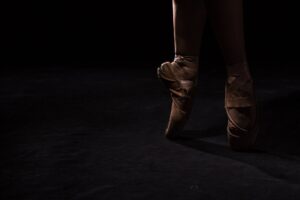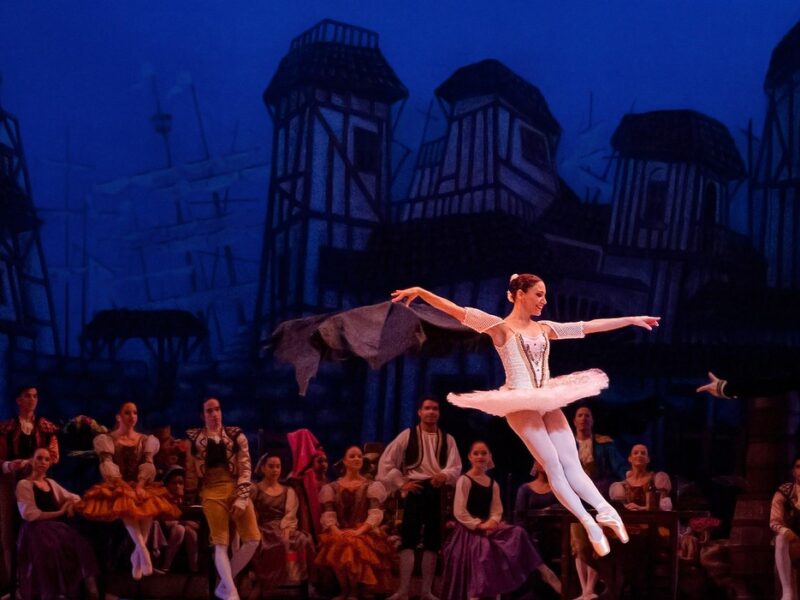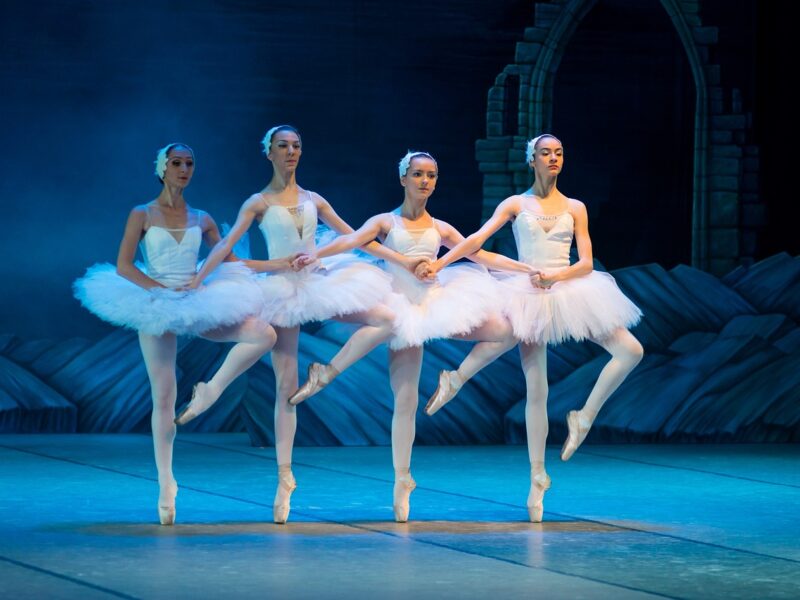First ever pair of pointe shoes? Exciting times, right? You’ve already slept in them, sewn the ribbons and darned the platform, but how are you planning on getting up on to that box when you relevé? Unfortunately, pointe shoes aren’t all sugar spice and all things nice. Well, they can be, but only if you put in the effort to make sure your feet and ankles are strong enough to cope with demands of dancing up on the tips of your toes. Luckily, my favourite foot strengthening exercises for pointe work can help…
I first starting dancing en pointe when I was 12, and since then, I’ve spent hours watching YouTube tutorials and listening to various teachers and industry professionals, to find the best exercises for strengthening and stretching your feet and ankles for pointe work. Now it’s time for me to pass on a decades’ worth of knowledge to you! So, what are you waiting for? Stick on those boots and get strengthening with me…
(If these exercises leave you wanting more, check out my article The Best Foot Strengthening Exercises for Dancers)

Exercise #1 – Calf Raises in Second Position
Let’s start with an obvious one but a brilliant exercise none the less. Calf raises are great for building stability in your ankles and for strengthening the Achilles tendon, which is oh so important for ladies (and gents) dancing en pointe to help prevent Achilles Tendonitis!
Always perform calf raises both bare foot and in your pointe shoes to ensure that you develop enough strength to rise up on to the platform of your shoes. Calf raises are also a great way of breaking in new pair of pointes, as they help to increase flexibility in the shank.
Have a go at some calf raises in the centre without holding the barre. The added challenge of staying on balance will not only help in your quest for stronger ankles, but will also target your core and glutes.
Step 1) Stand facing the barre in second position.
Step 2) Rise up onto demi pointe or the platform of your pointe shoe.
Step 3) Lower by rolling down through the demi pointe.
Exercise #2 – Single Leg Calf Raises
These bad boys are pretty much the same as the above, however they are much harder and require a lot more strength to perform (especially if you are doing so in pointe shoes). Single leg calf raises should be a part of your daily strengthening routine. Start at the barre, holding your working leg in cou-de-pied position, and when this gets too easy, try moving it up to passé. If you’re feeling really strong, try performing your single leg calf raises in attitude!
When you come to performing single leg calf raises in pointe shoes, make sure that you’re not leaning on the barre and pushing yourself up using your arms. Doing so will prevent you from developing strength in your feet and ankles. If you’re struggling, go back to bare foot and ask your ballet teacher for some advice.
Have a go at performing single leg calf raises in the centre with bare feet. Let me warn you, this won’t be easy at first, but the added task of balancing will help improve your ankle strength to no end. Try and aim for 20 reps on each leg, but always remember to go easy on yourself and build up slowly. Rome wasn’t built in a day!!!
Step 1) Stand facing the barre with the working leg in cou-de-pied.
Step 2) Using the supporting leg, rise on to demi pointe or the platform of your pointe shoe.
Step 3) Lower by rolling through the demi pointe.
Exercise #3 – Demi Pointe-to-Pointe Rises
This foot strengthening exercise can only be performed when wearing pointe shoes, and as the name suggests, it involves rising up on to the platform of your shoe from demi pointe, before lowering again to the same starting position.
This is a fantastic one for training your feet to roll up through the demi pointe on to the platform of the shoe, rather than only getting there through the momentum from your relevé.
Working through the demi pointe will not only improve the flexibility in the shank of your shoe, but will also strengthen the toes and activate the intrinsic muscles of the foot which can aid in the prevention of bunions.
Try this exercise in second position first before moving on to each leg separately.
Step 1) Start facing the barre in second position on demi pointe.
Step 2) Rise up on to the platform of the shoe.
Step 3) Lower back down to demi pointe.
Exercise #4 – Pointing in to a resistance band
Take off the boots and have a seat. This foot strengthening exercise is another brilliant one for activating the intrinsic muscles of the foot, which are responsible for not only preventing/improving bunions, but can also help dancers to achieve the ‘banana foot’ during pointe work.
By pointing your foot against the resistance of a theraband, the intrinsic muscles are strengthened, which will allow you to achieve a gorgeous arch even through the rigid shank of your pointe shoes!
Step 1) Sit on the floor with one leg stretched out in front of you.
Step 2) Wrap a theraband around your toes and hold it at either end so that you feel a resistance.
Step 3) Point your toes into the theraband. Make sure this movement is slow and controlled, you don’t want the band to ‘ping’ your toes.
Step 4) Flex your foot.
Exercise #5 – Big Toe Lifts
The hallucis brevis muscle works in conjunction with the hallucis longus muscle, and together they allow us to point and flex our toes.
When dancing en pointe, we are constantly pointing and flexing our toes, whether this be while rising up on to the platform of our shoes through the demi pointe, or as we tendu in preparation for posé turns.
The shanks of our shoes need to be fairly rigid to support our weight as we dance en pointe, however this added resistance makes pointing and flexing even harder, meaning it’s even more important that we activate and strengthen our hallucis brevis and hallucis longus muscles to achieve high demi-pointes and amazing arches.
Step 1) Sitting down, wrap a theraband band around the big toe and hold it at either end to create resistance.
Step 2) Relax the big toe, allowing it to be lifted off the floor by the theraband.
Step 3) Push the big toe downwards against the resistance of the band so that it touches the floor in line with the other toes.
Exercise #6 – Metatarsal Stretch
Metatarsalgia is a condition which commonly affects dancers, and occurs when the metatarsal bones in the foot become inflamed.
Stress on the balls of the feet from continuously dancing en demi pointe, as well as the impact on the foot from grand allegro, is often the cause of metatarsalgia, however the condition can be exacerbated by wearing tight-fitting pointe shoes. Metatarsalgia can be combatted and prevented by stretching the metatarsals.
Step 1) Place a golf or lacrosse ball under the big toe, keeping the rest of your foot flat on the floor.
Step 2) Use your finger to massage the top of the toe.
Step 3) Repeat for each toe.
Exercise #7 – Kneeling Upper Instep Stretch
In combination with strength training, in order to achieve gorgeous arches in your pointe shoes you will also need to stretch the upper instep of your feet.
Dancers with strong but inflexible feet will struggle to master the aesthetic aspects of pointe work, and may even have trouble getting up on to the platform of their shoes.
Step 1) Kneeling down on one leg, place your other foot vertically underneath you with your toes tucked away.
Step 2) Support the foot gently at either side with your hands to prevent sickling.
Step 3) Push into your instep until you feel a stretch along the top of the foot.
Exercise #8 – Pressing into the Arch
Similar to the above, pressing or pointing into the arch of your pointe shoes will help to stretch your upper instep, however the big bonus of this exercise is that it’s also a great way of breaking in stubborn shoes as it increases flexibility in the shank.
Step 1) Facing the barre, tendu your left leg to second.
Step 2) Shift your weight on to your left leg, pushing into the arch of your pointe shoe until you feel a stretch.
Step 3) Repeat on the other side.
Final thoughts of Foot Strengthening for Pointe Work
Although foot strengthening exercises for pointe work are often seen as boring by dancers, it’s so important that you continue to stretch and strengthen your feet, not only to improve your confidence and ability during pointe class, but also to prevent injury. For more exercises to help keep your feet strong and supple, follow the link to my article The Best Foot Strengthening Exercises for Dancers. See you there!
**FRIENDLY DISCLAIMER: All information, guidance or advice provided on this site is for informational and educational purposes only. The use of this information is at your own risk. **

